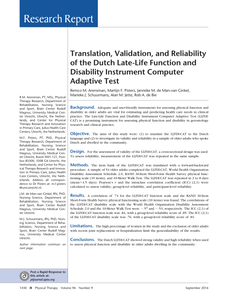The last decade has seen an increasing demand from the industrial field of computerized visual inspection. Applications rapidly become more complex and often with more demanding real time constraints. However, from 2004 onwards the clock frequency of CPUs has not increased significantly. Computer Vision applications have an increasing demand for more processing power but are limited by the performance capabilities of sequential processor architectures. The only way to get more performance using commodity hardware, like multi-core processors and graphics cards, is to go for parallel programming. This article focuses on the practical question: How can the processing time for vision algorithms be improved, by parallelization, in an economical way and execute them on multiple platforms?
DOCUMENT

DOCUMENT

Participating in physical activity (PA) is beneficial for adolescents' physical and mental development. Therefore, many studies have been conducted to design and evaluate interactive interventions to facilitate adolescents' PA. Despite the knowledge produced by this large number of studies, the field of Human-Computer Interaction (HCI) still lacks a comprehensive set of guidelines to guide our design processes, help us make informed design decisions, as well as provide niche for innovation. This paper reports a systematic literature review of studies on technology-supported interventions in adolescents' PA. We reviewed 25 design related studies in HCI over the past 10 years, analyzing 1) the process phases of design practice, 2) the design requirements and related design decisions, and 3) how these phases and requirements are internally related to each other and what are their influence on design value. Our findings suggest four design phases with seven design requirements and its corresponding design decisions emerged in the process of design. Furthermore, we outline a framework to demonstrate the internal relations of design requirements. We generalize opportunities and challenges for supporting the aforementioned design decisions making, and implementing the findings for future design and research on technology-supported adolescents' PA. https://doi.org/10.1145/3311927.3323130
DOCUMENT
Brochure from the Inauguration of Klaas Dijkstra, professor Computer Vision and Data Science
DOCUMENT
![I’M A.I. IMage Processing and Artificial Intelligence [Inaugurele rede]](https://publinova-harvester-content-prod.s3.amazonaws.com/thumbnails/files/previews/pdf/20250506132441657988.LS20Brochure20Professorship20CVDS20FINAL20WEB2028129-thumbnail-400x300.png)
This paper describes the work that is done by a group of I3 students at Philips CFT in Eindhoven, Netherlands. I3 is an initiative of Fontys University of Professional Education also located in Eindhoven. The work focuses on the use of computer vision in motion control. Experiments are done with several techniques for object recognition and tracking, and with the guidance of a robot movement by means of computer vision. These experiments involve detection of coloured objects, object detection based on specific features, template matching with automatically generated templates, and interaction of a robot with a physical object that is viewed by a camera mounted on the robot.
DOCUMENT

Background. Adequate and user-friendly instruments for assessing physical function and disability in older adults are vital for estimating and predicting health care needs in clinical practice. The Late-Life Function and Disability Instrument Computer Adaptive Test (LLFDICAT) is a promising instrument for assessing physical function and disability in gerontology research and clinical practice. Objective. The aims of this study were: (1) to translate the LLFDI-CAT to the Dutch language and (2) to investigate its validity and reliability in a sample of older adults who spoke Dutch and dwelled in the community. Design. For the assessment of validity of the LLFDI-CAT, a cross-sectional design was used. To assess reliability, measurement of the LLFDI-CAT was repeated in the same sample. Methods. The item bank of the LLFDI-CAT was translated with a forward-backward procedure. A sample of 54 older adults completed the LLFDI-CAT, World Health Organization Disability Assessment Schedule 2.0, RAND 36-Item Short-Form Health Survey physical functioning scale (10 items), and 10-Meter Walk Test. The LLFDI-CAT was repeated in 2 to 8 days (mean4.5 days). Pearson’s r and the intraclass correlation coefficient (ICC) (2,1) were calculated to assess validity, group-level reliability, and participant-level reliability. Results. A correlation of .74 for the LLFDI-CAT function scale and the RAND 36-Item Short-Form Health Survey physical functioning scale (10 items) was found. The correlations of the LLFDI-CAT disability scale with the World Health Organization Disability Assessment Schedule 2.0 and the 10-Meter Walk Test were .57 and .53, respectively. The ICC (2,1) of the LLFDI-CAT function scale was .84, with a group-level reliability score of .85. The ICC (2,1) of the LLFDI-CAT disability scale was .76, with a group-level reliability score of .81. Limitations. The high percentage of women in the study and the exclusion of older adults with recent joint replacement or hospitalization limit the generalizability of the results. Conclusions. The Dutch LLFDI-CAT showed strong validity and high reliability when used to assess physical function and disability in older adults dwelling in the community.
MULTIFILE
